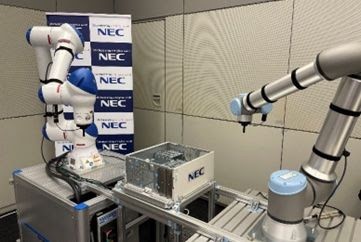If commercialized by 2025, it will be the first full-scale use of such a technology in the automobile industry in Japan.
Producing a motion plan for industrial robots used to take engineers in the automobile industry around 40 days. Now, two Japanese firms have conducted demonstrations of their collaborative AI research to generate motion plans for multiple robots in just one day.

In addition, the use of AI can reduce the time required for the manufacturing process by approximately 10% with the optimal motion plans.
Based on these preliminary success of the demonstrations, the two firms —Yazaki Corporation and NEC Corporation, have begun testing for mass production of wire harnesses in October 2023, with the aim of commercializing a system in July 2025. This will be the first full-scale use in Japan of a solution that uses AI to automatically generate motion plans for multiple robots to support the manufacture of multiple types of wire harnesses.
While NEC provided the digital robot motion planning solution, Yazaki Corporation’s robot system and simulator for a wire harness assembly was used for tests. The system involves the following:
- Wire-harness product data, such as product design and work content, are input into the AI.
- The AI and a simulator are linked. This automatically generates a motion plan that minimizes manufacturing time while at the same time ensuring that multiple robots and surrounding equipment do not interfere with each other.
- If there is interference after operation, the AI is notified and it then recalculates a motion plan to avoid interference. Furthermore, when new products are introduced, or product specifications are changed, motion plans can be quickly updated by with the input of new product data into the AI, eliminating the need for complex teaching processes.
- By linking AI, which automatically generates motion plans, with production planning and performance data, energy consumption can be predicted and measured, contributing to the management of carbon neutrality.
The solution is expected to contribute to stable production and quality improvement through the realization of digital twins in the manufacturing field.
